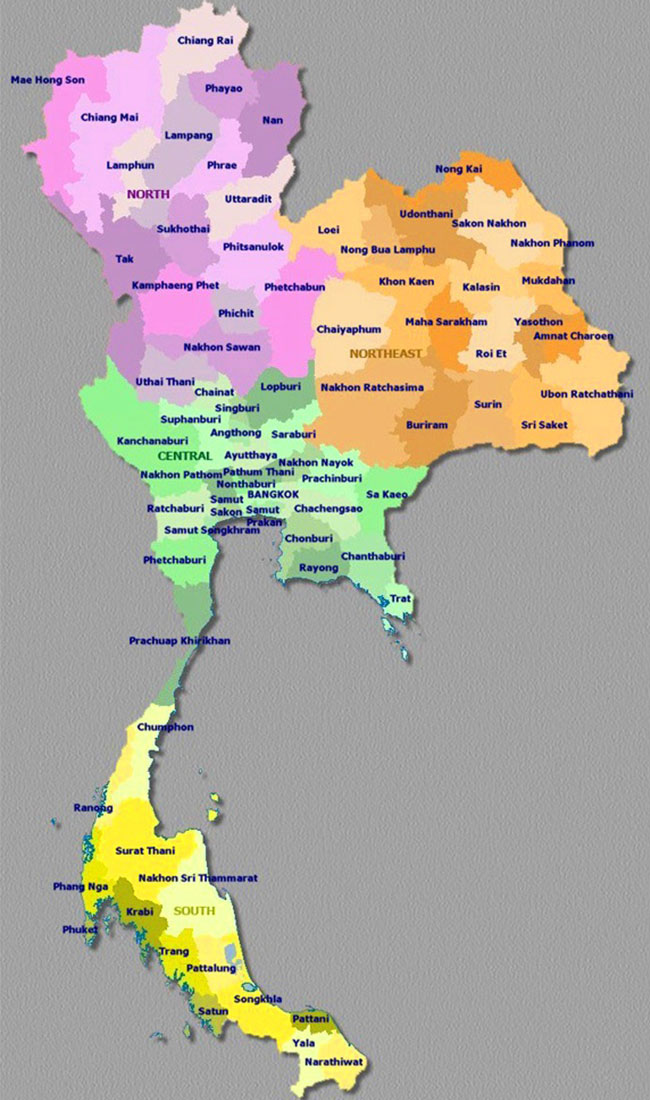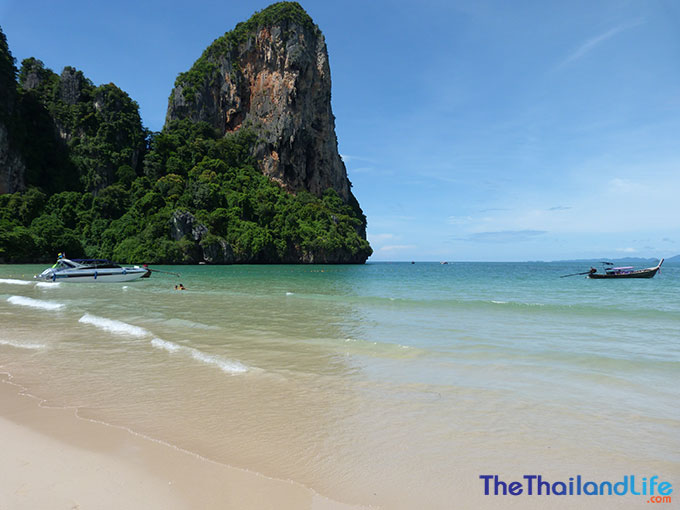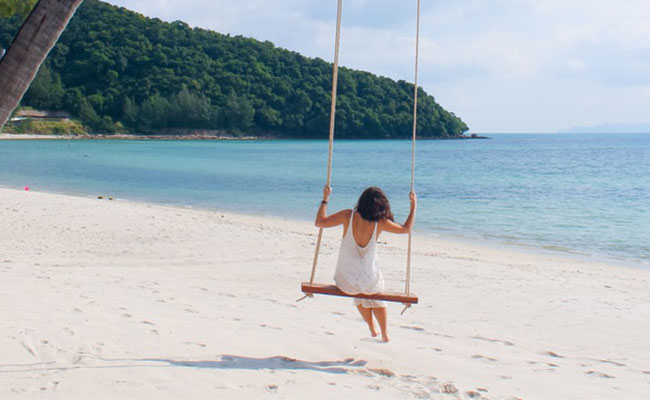If you're looking for a map of Thailand, this is a pretty good one to get an overview of the regional boundaries.
It is color coded by region, carving up the Central, South, North, and Northeast Thailand, and features the main provinces.
It's not the best quality and is a little dated now, but I'm planning on getting a better version done.
I've written a little overview of each region to give you a feel for the area.
I've also included links on certain names of places that will take you to articles that offer further information about that place – in an attempt to make this more than just a map of Thailand 🙂
North of Thailand (Pink)
The pink section of this map of Thailand highlights the delightful North.
Deep set in history of kingship, war, and cross territory trade, the north is of huge historical importance to Thailand, not least because here, in Sukhothai province, King Ram Khamhaeng, the third king of the Phra Ruang dynasty, is said to have created the Thai alphabet.
The North is home to a unique and diverse mix of culture that spans Burmese, Yunnan, Thai, and Laotian, along with numerous tribal peoples.
There are 9 main tribal groups in the North:
- Karen
- Hmong
- Mien (Yao)
- Lahu
- Lisu
- Akha
- Lua
- Khamu
- Thin
The Long neck Karen are among the most fascinating for visitors because of the brass coils worn around the female tribe member's necks.
The most popular city in the North, at least for foreign folk, is Chiang Mai, which offers a great balance between city and rural life and makes a good alternative to Bangkok living.
That said, you'll find expats living all over the North, as it's a really easy place to lose a few years living well for cheap among the easy-going Northern folk.
The North is blessed with beautiful landscape, with places such as Pai, Nan, and Chiang Rai offering endless natural beauty.
Northeast – Isaan (Orange)
The orange section shows the Northeastern region of Thailand, more commonly know as “Isaan” (sometimes spelt Isan or Esarn).
For the most part the Northeast is flat and dry. Its vast, open plains make it very hot and not the most desirable part of Thailand to live.
That said, the region is known for its hospitality, colorful characters and laid back way of life.
Isaan is the backbone of the rice production industry and historically the poorest region of Thailand. It's blood, sweat, and tears to earn a crust in the deep rural parts, which is why so many from poorer backgrounds migrate to Bangkok for work.
Archaeologically, the area is of great importance. Evidence has been found in the Khorat Plateau of prehistoric inhabitants who may have forged bronze implements as early as 3000 B.C. and cultivated rice during the fourth millennium B.C.
Of particular interest is the Ban Chiang UNESCO archaeological site in Udon Thani Province, where remains have been found of some of the earliest people to have inhabited Thailand as we know it today (1).
Additionally, the Sirindhorn Museum and Phu Kum Khao Dinosaur Excavation Site in Kalasin, and the ancient Khmer temples in Roi Et, are notable historical sites worthy of a visit.
The Isaan region occupies a large part of Thailand's land mass and houses a population of approximately 25 million, over a third of Thailand's total population.
People to the north of the region speak a mixture of Laotian and Thai, known as Thai-Isaan, and in the South of Isaan – in Korat, for example – a mixture of Khmer and Thai.
Home to more temples than you'll ever want to visit, unique Isaan cuisine, and a cross section of culture, Isaan never fails to charm, whatever corner you visit.
Southern Thailand (Yellow)
The South is unique in many ways, not least because like the North and Northeast, it has its own regional dialect, which is generally difficult for Thais form other areas of the country to understand.
Situated on the Malay peninsula, each year millions of travellers head to the fantastic beaches on one of the many islands like Phuket, Samui, Railay, Koh Phangan, etc.
The South needs no talking up. It's blessed with stunning beaches and bays, island getaways and beautiful national parks such as Khao Sok, which boasts virgin jungle and tower-like limestone karst formations.
There is a darker side, though. The deeper, southernmost provinces of Yala, Pattani ,and Narathiwat have struggled with an Islamic insurgency over the years.
The insurgency’s roots date back to Thailand’s annexation and conquest of the Malay Sultanate of Patani. Following the annexation, a series of forced assimilation measures stoked tensions and failed to take hold, leaving the area disenfranchised up until the modern day.
Thankfully, although deserted during the COVID-19 scare, the tourist areas of the upper South have always remained unaffected by violence and flourished on the tourist dollar.
That said, tourism accounts for only 8% of the South's gross regional product. The biggest portion comes from agriculture at 27% (2).
Central Thailand (Green)
Central Thailand is home to Bangkok, aka the City of Angels, or Krung Thep Maha Nakhon, to say its full name.
Well, actually, not quite, this is still an abbreviation of the city's full ceremonial name, which is the longest place name in the world.
Bangkok's full name is:
Krung Thep Maha Nakorn Arun Rattanakosin Mahinthara Ayutthaya Mahidol Pop Noppharat Ratchathani Burirom Udomratchawiwet Makhasathan Amon Phiman Awatan Sathit Sakkathattiya Witsanukam Prasit.
I, like many, prefer the Big Mango.
Not for the faint hearted, Bangkok is a city that must be experienced for its 24-hour, anything goes atmosphere, street markets and general fusion of Thai culture.
Once you reach the point of overexposure, you can take a 4-hour drive to the divine Kanchanaburi, home to the River Khwae and many delightful beauty spots.
It's here that you'll also find the Death Railway, built during WWII and featured in the hit film The Railway Man.
Or perhaps head two hours south for a quick beach break in the quaint, royal town of Hua Hin, or head in the opposite direction for a break to Sin City (Pattaya), in Chonburi.
If you're in the region, travel 80 kilometers from Bangkok to Ayutthaya and see the ancient temples. Ayutthaya was the Siamese capital for four centuries, until it was all but destroyed by the Burmese in the 18th century. It's now a UNESCO-listed area and offers a glimpse of its former glory.
———
What's your favorite region of Thailand?
What provinces have you visited and what were your experiences?
Leave your comments below.
Last Updated on




JamesE says
Also, I must disagree with you about Bangkok. While probably not for the "faint" hearted, the "feint" hearted should do quite well there.
As for regions, I am partial to the North. From wild mountains to the refined beauty of the Royal Gardens of Doi Tung (where you can actually tour a royal residence when unoccupied) all connected by some of the most enjoyable driving roads in the country. Plus: khao soi.
Nov 07, 2020 at 12:54 am
TheThailandLife says
Nov 07, 2020 at 3:06 am
David says
Would it be possible to use this map in the thesis? It will be fully referenced to here if so.
Thanks!
David
Apr 04, 2015 at 3:47 pm
TheThailandLife says
Apr 04, 2015 at 4:01 pm
Jeremy Becker says
My wife and I are opening a Thai grocery store in West Hartford, CT. And we would like to ask your permission to use your map of Thailand on our website. We would be happy to credit your website on our website in exchange for use of the map. Please email me ASAP and let me know. Thank you very much and have a nice day.
Respectfully,
Jeremy & Areeya Becker
May 15, 2012 at 12:38 am
TheThailandLife says
May 15, 2012 at 4:47 pm
tom says
Aug 18, 2011 at 2:51 pm
TheThailandLife says
Aug 18, 2011 at 8:06 pm
Sitt says
Your have a good map of Thailand that we would like to ask for your permittion for using in our blog (we will credit your url and thank for your kindness )
Forward with thank and friendly love,
Sitt
Jun 29, 2011 at 10:54 am